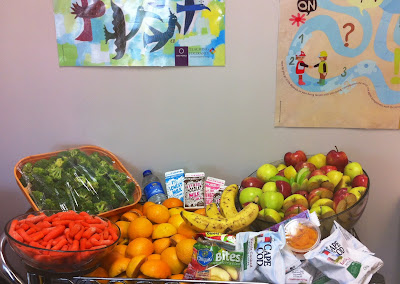On October 22nd, about forty-five 5th grade students arrived to school a little earlier than usual so that they could have a chance to eat breakfast and begin preparing for Bayyari Elementary’s first food waste audit. The idea for a food waste audit came to me on my first day of service as I was helping out in the school cafeteria. Being new to Bayyari, I was pleasantly surprised as I stood next to the cafeteria’s salad bar watching student after student serve themselves an “all you can eat” helping of fresh fruits and vegetables. I did not know it then, but a few minutes later those immaculate pieces of fruits and veggies would be in the trash. By the end of the lunch period I was shocked at all the produced that was thrown away.
Surely this had to have been a bad day, I thought to myself. The next day I checked in again only to find that hundreds of students were throwing away whole, unpeeled bananas! After talking to some of the cafeteria staff and teacher monitors, I found out that students had to take the bananas to fulfill their federal fruit requirement for the day. I was not the only one who felt unsettled by the cafeteria food waste. Coincidently, I had just meet Rob Moore, an Environmental Educator from Boston Mountain Solid Waste District, who had worked with Bayyari’s Gifted and Talented students the year prior. We discussed the food waste issue and ultimately started to plan the food waste audit.
 |
| These kids weren't afraid to get their hands dirty! |
Finally, our food audit day had arrived and the kids were ready to take on the challenge - fully equipped with plastic gloves, heavy-duty trash bags, and luggage scales.
brought them snacks to eat. Some students even thought we were going to do a cooking lesson. When I finally told them that the food was recovered from the cafeteria trash bins, they were upset. The students were even more confused when they realized that due to health code regulations, we could not give the food away. These realizations led to a rich discussion with my 5th grade class about food waste, composting, landfills, poverty/food insecurity, and gleaning. In the end, the kids worked hard to collect the “waste.” Together we learned some valuable lessons, but the results were more bitter than sweet.
After the students collected the food, they then sorted and determined the pounds of food waste at breakfast that morning. They separated the waste into three piles: Trash, Food, and Milk. Directly following our morning collection, the students went off to class while Rob and I set up the bins and trash bags for the food waste collection at lunch. At the end of the day, I created a display of some of the food that was still "untouched" for some students and staff to see. When I rolled in the cart with the display of food, many of the students became excited and thought I had
In our day of food waste collection at the school, we gathered the following data (a majority of which was calculated in a 5th grade math lesson):
Breakfast:
Food: 40 lbs.
Milk: 231 unopened milk cartons
Lunch:
Food: 180lbs
Milk: 75.4 lbs (liquid milk separated from the carton by students at lunch)
The food waste in pounds may or may not seem like much for a day, but when replicated over a year, or a student’s 6-year (k-5th grade) elementary career, the numbers escalate very quickly.
Food Waste over 1 year at Bayyari Elementary School:
Breakfast:
Food: 7,200 lbs.
Milk: 41,580 unopened milk cartons
Lunch:
Food: 32,400 lbs
Milk: 13,572 lbs (liquid milk separated from the carton by students at lunch)
Food Waste over a 6 year span of the typical elementary student (K-5th grade):
Breakfast:
Food: 143,200 lbs.
Milk: 249,480 unopened milk cartons
Lunch:
Food: 194,400 lbs
Milk: 122,148 lbs (liquid milk separated from the carton by students at lunch)
For one day, at one school, with 640 students, we collected enough milk and food to feed several of the families in the community that are struggling with food insecurity. At Bayyari Elementary alone, roughly 95% of the families qualify for free or reduced school meals.
It is hard to come up with a decent response when several of the students ask why it is against “regulations” to redistribute “untouched & unopened” food and milk cartons to families in need.
I have always had a passion for reforming our food system, and this food audit is another small insight to a complex problem. Although the students, staff and I were baffled by the data, I see opportunity for change in their bitter reactions to the results. I hear creativity in action when my 5th grade students talking about solution. Working with food service staff to plan cafeteria taste tests to help students appreciate healthy produce revitalizes my spirits.
Check back for updates on how we’re serving in Springdale, Arkansas to create healthier student bodies - not healthier school trash cans.
- by Cecilia Hernandez












